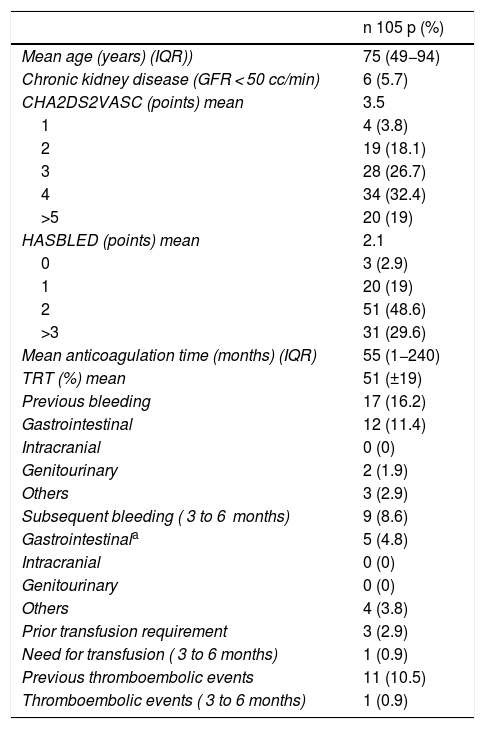Atrial fibrillation and anticoagulation decrease the quality of life of patients. The aim of this study is to assess the quality of life and the degree of satisfaction after changing from VKA to edoxaban anticoagulants.
Material and methodsProspective, multicentre study, including 105 patients in dicumarinic anticoagulant treatment replaced by edoxaban. Their quality of life was evaluated before and after using the EQ-5D questionnaire, and the degree of satisfaction with CRES-4 scale.
ResultsAverage 75 years, CHA2DS2VASC 3.5 and HASBLED 2.1; thromboembolic events and clinically relevant bleeding during follow-up <1%. EQ-5D showed a significant overall improvement in the mobility and anxiety parameters (P = 0.023, 95% CI: 0.0175–0.23; P = 0.019, 95% CI: = 0.028–0.31). The CRES-4 questionnaire showed satisfaction with the therapist of 95%, a positive impact on life of 73% and a negative impact of 3.8%. The emotional state attributed to the change in treatment improved (41% vs 69.5%, P = 0.0001). The final score of the CRES-4 weakly correlated with the emotional situation of the EQ-5D questionnaire.
ConclusionsThe change of anticoagulant for edoxaban improves the quality of life and the degree of patient satisfaction, and the EQ-5D and CRES-4 quality of life questionnaires can be used complementarily.
La fibrilación auricular y la anticoagulación merman la calidad de vida de los pacientes. El objetivo del estudio es valorar la calidad de vida y el grado de satisfacción tras el cambio de anticoagulante de AVK a edoxabán.
Material y métodosEstudio prospectivo, multicéntrico, que incluye a 105 pacientes en tratamiento con dicumarínicos que se sustituye por edoxabán. Se valoró la calidad de vida antes y después a través del cuestionario EQ-5D y el grado de satisfacción con la escala CRES-4.
ResultadosEdad media 75 años, CHA2DS2VASC 3.5 puntos, HASBLED 2.1 puntos; eventos tromboembólicos y hemorragias clínicamente relevantes durante el seguimiento <1%. El EQ5D mostró una mejoría global significativa en los parámetros de movilidad y ansiedad (p = 0.023, IC 95%: 0.0175–0.23; p = 0.019, IC 95%: 0.028–0.31). El CRES-4 recoge una satisfacción con el terapeuta del 95%, una repercusión positiva en la vida del 73% y negativa del 3.8%. La situacional emocional atribuida al cambio de tratamiento mejoró (41% vs 69.5%, p = 0.0001). Se correlacionó débilmente la puntuación final del CRES-4 con la situacional emocional del EQ-5D.
ConclusionesEl cambio de anticoagulante por edoxabán mejora la calidad de vida y el grado de satisfacción del paciente, pudiendo emplearse conjuntamente los cuestionarios de calidad de vida EQ-5D y el CRES-4.









